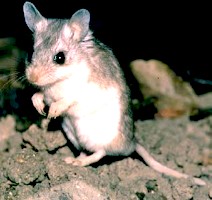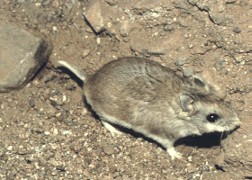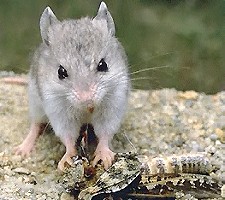 Have you ever heard of carnivorous mice whose diet is almost all meat ... mice which stalk their prey and kill with a swift bite to the neck? Mice which bark, and rear up on their hind to howl like a wolf? You think we're joking, don't you?! We're not! We're about to introduce you to the tiny Grasshopper Mouse, which does all of these things and more.  The Grasshopper Mouse can be found in Western North America, and is is comprised of two species of carnivorous mice which are found in dry, open country. The two species are the northern grasshopper mouse (Onychomys leucogaster) and the southern grasshopper mouse, or scorpion mouse.
The Grasshopper Mouse can be found in Western North America, and is is comprised of two species of carnivorous mice which are found in dry, open country. The two species are the northern grasshopper mouse (Onychomys leucogaster) and the southern grasshopper mouse, or scorpion mouse.The northern grasshopper mouse can be found as far north as western Canada. It has a thick body and short tail which is white underneath and at the tip. Its fur is reddish brown or grey on top, and white underneath. The mouse's body is about 15 cm long. The northern grasshopper mouse is nocturnal. It lives in dry, sandy areas, and likes to take 'sand baths'. Mated pairs do not tolerate other grasshopper mice in their territory, and will warn others away with short barking sounds and sometimes a high-pitched 'howl', much like that of a wolf.  Unlike most mice, the grasshopper mouse's diet is almost entirely meat. It is a carnivore, and a voracious killer. It stalks its prey, which might be a grasshopper, other insects or invertebrates, a small mammal, or a small rodent. It grasps its prey with its long claws and kills it with a quick bite to the neck with its long front incisor teeth. Unlike most mice, the grasshopper mouse's diet is almost entirely meat. It is a carnivore, and a voracious killer. It stalks its prey, which might be a grasshopper, other insects or invertebrates, a small mammal, or a small rodent. It grasps its prey with its long claws and kills it with a quick bite to the neck with its long front incisor teeth. The southern grasshopper mouse is very similar in appearance, perhaps being more greyish brown on top. It lives in the southwest United States, in hot dry grassland areas. The adult males are highly territorial. Like their northern cousins, they frequently vocalize at night. They emit a high-pitched call, lasting several seconds, while standing on their hind legs with head raised and mouth open. The southern grasshopper mouse is very similar in appearance, perhaps being more greyish brown on top. It lives in the southwest United States, in hot dry grassland areas. The adult males are highly territorial. Like their northern cousins, they frequently vocalize at night. They emit a high-pitched call, lasting several seconds, while standing on their hind legs with head raised and mouth open.Grasshopper mice can have up to three litters a year; the male and female rear their young together. They remain active year round, but will stay in their burrows during wet or cold weather. They live about three years. The grasshopper mouse is preyed upon itself by owls, foxes, coyotes, bobcats, snakes and other small predators, and of course, its habitat is being destroyed in some places by human development. |